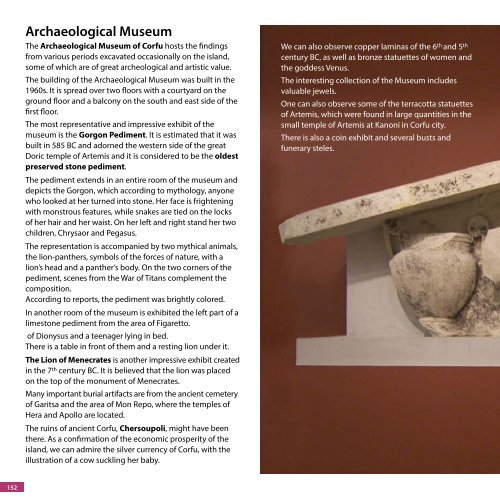Create successful ePaper yourself
Turn your PDF publications into a flip-book with our unique Google optimized e-Paper software.
Archaeological Museum<br />
The Archaeological Museum of Corfu hosts the findings<br />
from various periods excavated occasionally on the island,<br />
some of which are of great archeological and artistic value.<br />
The building of the Archaeological Museum was built in the<br />
1960s. It is spread over two floors with a courtyard on the<br />
ground floor and a balcony on the south and east side of the<br />
first floor.<br />
The most representative and impressive exhibit of the<br />
museum is the Gorgon Pediment. It is estimated that it was<br />
built in 585 BC and adorned the western side of the great<br />
Doric temple of Artemis and it is considered to be the oldest<br />
preserved stone pediment.<br />
The pediment extends in an entire room of the museum and<br />
depicts the Gorgon, which according to mythology, anyone<br />
who looked at her turned into stone. Her face is frightening<br />
with monstrous features, while snakes are tied on the locks<br />
of her hair and her waist. On her left and right stand her two<br />
children, Chrysaor and Pegasus.<br />
The representation is accompanied by two mythical animals,<br />
the lion-panthers, symbols of the forces of nature, with a<br />
lion’s head and a panther’s body. On the two corners of the<br />
pediment, scenes from the War of Titans complement the<br />
composition.<br />
According to reports, the pediment was brightly colored.<br />
In another room of the museum is exhibited the left part of a<br />
limestone pediment from the area of Figaretto.<br />
of Dionysus and a teenager lying in bed.<br />
There is a table in front of them and a resting lion under it.<br />
The Lion of Menecrates is another impressive exhibit created<br />
in the 7 th century BC. It is believed that the lion was placed<br />
on the top of the monument of Menecrates.<br />
Many important burial artifacts are from the ancient cemetery<br />
of Garitsa and the area of Mon Repo, where the temples of<br />
Hera and Apollo are located.<br />
The ruins of ancient Corfu, Chersoupoli, might have been<br />
there. As a confirmation of the economic prosperity of the<br />
island, we can admire the silver currency of Corfu, with the<br />
illustration of a cow suckling her baby.<br />
We can also observe copper laminas of the 6 th and 5 th cenWe<br />
We can also observe copper laminas of the 6 th and 5 th<br />
century BC, as well as bronze statuettes of women and<br />
the goddess Venus.<br />
The interesting collection of the Museum includes<br />
valuable jewels.<br />
One can also observe some of the terracotta statuettes<br />
of Artemis, which were found in large quantities in the<br />
small temple of Artemis at Kanoni in Corfu city.<br />
There is also a coin exhibit and several busts and<br />
funerary steles.<br />
152



